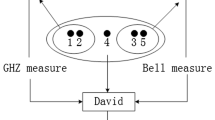Abstract
A quantum proxy signature scheme by using random sequence to blind the message is proposed. Our scheme introduces the trusted party Trent and enhances the eavesdropping check to ensure higher security. It only uses the Von Neumann measurement, which reduces measurement times and improves efficiency. Meanwhile, our scheme uses random sequence to enhance message’s blindness. We use the physical characteristics of quantum mechanics to guarantee scheme’s blindness, unconditional security, unforgeability, undeniability.

Similar content being viewed by others
References
Wang, T.Y., Wei, Z.L.: Analysis of forgery attack on one-time proxy signature and the improvement. Int. J. Theor. Phys. 55(2), 743–745 (2016)
Zou, X., Qiu, D.W.: Security analysis and improvements of arbitrated quantum signature schemes. Phys. Rev. A 82(4), 42325–0 (2010)
Tian, J.H., Zhang, J.Z., Li, Y.P.: A quantum muti-proxy blind signature scheme based on genuine four-qubit entangled state. Int. J. Thero. Phys. 55(2), 809–816 (2015)
Guo, W., Zhang, J.Z., Li, Y.P.: Multi-proxy strong blind quantum signature scheme. Int. J. Theor. Phys. 55(8), 3524–3536 (2016)
Mambo, M., Usuda, K., Okamoto, E.: Proxy signatures for delegating signing operation. In: Proceedings of the 3Rd ACM Conference on Computer and Communications Security, pp. 48–57. New Delhi (1996)
Barnum, H., Crepeau, C., Gottesman, D., et al.: In: Proceedings of the 43th Annual IEEE Symposium on Foundations of Computer Science, pp 449–458 (2002)
Wang, T.Y., Wei, Z.L.: One-time proxy signature based on quantum cryptography. Quant. Inf. Process. 11(2), 455–463 (2012)
Xu, G.B.: Novel quantum proxy signature without entanglement. Int. J. Theor. Phys. 54(8), 2605–2612 (2015)
Cao, H.J., Wang, H.S., Li, P.F.: Quantum proxy multi-signature scheme using genuinely entangled six-qubit state. Int. J. Theor. Phys. 52(4), 1188–1193 (2013)
Cao, H.J., Huang, J., Yu, Y.F., et al.: A quantum proxy signature scheme based on genuine five-qubit entangled state. Int. J. Theor. Phys. 53(9), 3095–3100 (2014)
Guo, X., Zhang, J.Z., Xie, S.C.: An improved proxy blind signature scheme. Int. J. Theor. Phys. 58(2), 354–363 (2019)
Chaum, D.: Blind Signature for Untraceable Payments. Advances in Cryptology, pp. 199–203. Springer, New York (1982)
Wen, X.J., Niu, X.M., Ji, L.P.: A weak blind signature scheme based on quantum cryptography. Opt. Commun. 282(4), 666–669 (2009)
Wang, T.Y., Cai, X.Q., Zhang, R.L.: Security of a sessional blind signature based on quantum cryptograph. Quantum Info. Process 13(8), 1677–1685 (2014)
Zhang, J.Z., Yang, Y.Y., Xie, S.C.: An improved quantum proxy blind signature scheme based on genuine seven-qubit entangled state. Int. J. Theor. Phys. 56(7), 2293–2302 (2017)
Zhang, J.L., Zhang, J.Z., Xie, S.C.: Improvement of a quantum proxy blind signature scheme. Int. J. Theor. Phys. 57(6), 1612–1621 (2018)
Guo, W., Zhang, J.Z., Xie, S.C.: A novel quantum proxy blind signature scheme. Int. J. Theor. Phys. 56(5), 1708–1718 (2017)
Niu, X.F., Zhang, J.Z., Xie, S.C.: A quantum multi-proxy blind signature scheme based on entangled four-qubit cluster state. Int. J. Theor. Phys. 70(1), 43–48 (2018)
Jiang, D.H., Xu, Y.L., Xu, G.B.: Arbitrary quantum signature based on local indistinguishability of orthogonal product states. Int. J. Theor. Phys. 58, 1036–1045 (2019)
Zhang, K.J., Jia, H.Y.: Cryptanalysis of a quantum proxy weak blind signature scheme. Int. J. Theor. Phys. 54(2), 582–588 (2015)
Jiang, D.H., Wang, X.J., Xu, G.B., et al.: A denoising-decomposition model combining TV minimisation and fractional derivatives. East Asia J. Appl. Math. 8, 447–462 (2018)
Wang, T.Y., Cai, X.Q., Ren, Y.L., et al.: Security of quantum digital signatures for classical messages. Sci. Rep. 5, 9231 (2015)
Zeng, C., Zhang, J.Z., Xie, S.C.: A quantum proxy blind signature scheme based on genuine five-qubit entangled state. Int. J. Theor. Phys. 56(6), 1762–1770 (2017)
Shor, P.W., Preskill, J.: Simple proof of security of the BB84 quantum key distribution protocol. Phys. Rev. Lett. 85(2), 441–444 (2000)
Mayers, D.: Unconditional security in quantum cryptography. J. ACM 48(3), 351–406 (2001)
Inamon, H., Lutkenhaus, N., Mayers, D.: Unconditional security of practical quantum key distribution. Eur. Phys. J. D 41(3), 599–627 (2007)
Cao, H.J., Zhang, Y.Y., Li, P.E.: A quantum proxy weak blind signature scheme. Int. J. Thero. Phys. 53(2), 419–425 (2014)
Cao, H.J., Yu, Y.F., Qin, S.: A quantum proxy weak blind signature scheme based on controlled quantum teleportation. Int. J. Thero. Phys. 54(4), 1325–1333 (2015)
Cao, H.J., Zhang, J.F., Liu, J., et al.: A new quantum proxy multi-signature scheme using maximally entangled seven-qubit states. Int. J. Theor. Phys. 55(2), 774–780 (2016)
Acknowledgements
This work is supported by the National Natural Science Foundation of China (Grant Nos. 61402275, 61402015, 61273311), the Natural Science Foundation of Shaanxi Province (Grant Nos. 2015JM6263, 2016JM6069), and the Fundamental Research Funds for the Central Universities(Grant No. GK201402004).
Author information
Authors and Affiliations
Corresponding author
Additional information
Publisher’s Note
Springer Nature remains neutral with regard to jurisdictional claims in published maps and institutional affiliations.
Rights and permissions
About this article
Cite this article
Zhang, X., Zhang, JZ. & Xie, SC. A Quantum Proxy Signature Scheme by Using Random Sequence to Blind the Message. Int J Theor Phys 58, 2081–2090 (2019). https://doi.org/10.1007/s10773-019-04100-z
Received:
Accepted:
Published:
Issue Date:
DOI: https://doi.org/10.1007/s10773-019-04100-z




